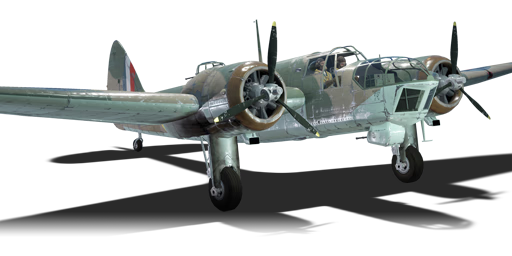



The Blenheim Mk IV is a British bomber. It has been in the game since the start of the Open Beta Test prior to Update 1.27.
The Blenheim IV is a light bomber, therefore base bombing in Realistic Battles isn't recommended, as the armament of 2 x 500 lbs bombs isn't enough for one or two runs against a base. The Blenheim's advantage over other bombers is its speed, so remembering and implementing this into tactics is vital. Low and fast tactics are normally best, try to avoid flying at medium altitudes or high altitudes, as accuracy will drop and you will be weak against attacks from below. Although the "red-line" speed of the Blenheim is high, dive bombing isn't as accurate as level bombing, so try to fly very low over the target to ensure a hit with the weaker payloads. The front turret guns have been modified to only fire rearwards, so the wing mounted gun which was only intended as a range finder in real life is your only FF weapon, but this can still ground attack un-armoured targets, with time and patience, although the turret method was easier.
The plane can also be used as a fighter. This is due to its supreme low-speed turn capabilities. The Blenheim turns into a Spitfire with flaps deployed, and the elevator fully extended. Surprising as it may sound, the frontal armament may prove devastating when used in a correct way. That is, if you load tracers, for not only unlike other ammunition choices it gives you a rough idea where the shells are going, but also it consists of the best shell composition, with a decent chance to light fires. As for the turrets, load universal, again due to its best shell composition.
The Blenheim can be absolutely deadly to other early planes, particularly as the biplanes it will be up against are often flown by inexperienced pilots who tend to position themselves right behind bombers at very close range while attacking -- in other words, their planes will be stationary relative to the gunner, and at such a close range that he simply cannot miss. Thus, a single Blenheim bomber picking off large numbers of enemy planes is a common sight. The Blenheim has one forward-firing weapon, but it's mounted far out on the wing, so hitting targets with it effectively requires some practice.
flaps
flaps
flaps
brake
| Belt | Belt filling | Armor penetration (mm) at a distance: | |||||
|---|---|---|---|---|---|---|---|
| 10 m | 100 m | 500 m | 1000 m | 1500 m | 2000 m | ||
| T/AP/AP-I/Ball/Ball/I | 13 | 12 | 7 | 3 | 2 | 0 | |
| T/AP/AP-I/AP-I/I | 13 | 12 | 7 | 3 | 2 | 0 | |
| IT/AP-I | 13 | 12 | 7 | 3 | 2 | 0 | |
| AP-I/AP-I/I | 13 | 12 | 7 | 3 | 2 | 0 | |
| Belt | Belt filling | Armor penetration (mm) at a distance: | |||||
|---|---|---|---|---|---|---|---|
| 10 m | 100 m | 500 m | 1000 m | 1500 m | 2000 m | ||
| T/AP/AP-I/Ball/Ball/I | 13 | 12 | 7 | 3 | 2 | 0 | |
| T/AP/AP/AP | 13 | 12 | 7 | 3 | 2 | 0 | |
| T/AP-I/AP-I/AP-I | 13 | 12 | 7 | 3 | 2 | 0 | |












Flight performance | |
|---|---|
Survivability |
|---|
Weaponry | ||
|---|---|---|